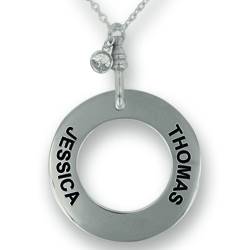Personalised jewellery evolution
 6.9 k views | By Naomi Levin
6.9 k views | By Naomi Levin
Personalised jewellery is evolving as consumer demand shows no sign of abating in 2011. Naomi Levin discovers how jewellers can tap into this burgeoning area of the market.
Jewellery is an innately personal thing. More than possibly any other retail purchase, jewellery is a reflection of the individual. From setting a grandmother’s stone into a new engagement ring, to selecting a gift that reflects the recipient’s personality, jewellery is about expression.As a new decade begins, more than ever personalisation has become the key to successful selling for every jeweller – from the stallholder at a craft market, to the diamond retailer at the top end of town. Even the editor of Vogue, the bible of style, says personalisation has reignited a love for and interest in jewellery, encouraging those jewellers not already doing it to cash in on the demand.
Trend expert Eryn Behan has noticed the creeping desire for personalisation, and says it will surely be “the next big thing downunder”. Although it is most popular at the high end, she says personalisation is slowly seeping through the market.
Yet it isn’t the high-end jewellers working on bespoke commissions that have propelled this phenomenon. There’s little doubt that the trend has been driven by the charm brand pioneers. For those consumers at the lower end of the market – the ones who might not be able to afford to walk into a store and commission a bespoke piece of jewellery – the rise of brands such as Pandora has opened up a world of customisation and self-expression that, at one time in the not too distant past, would have been out of their reach.
What has followed is an explosion of colour, icons and materials, all being tailor-made into jewellery that reflects the wearer’s dreams, aspirations and lifestyle. It may have started with the branded charms revival, but where will it end up?
Behan points out that this phenomenon has become noticeable not just in jewellery, but in the whole gamut of fashion clothing and accessories.
“This is really because of how accessible fashion is to everyone now,” Behan, the managing director at Melbourne-based Ginger Trend Consulting, says. “Even if someone chooses to wear the latest seasonal trends they can still make it unique by adding their own personal flair to complete an outfit.”
And after decades of cheap, overseas manufactured products, she says customers want more than just an item that everyone else has and a pocketful of change. “Consumers are changing their purchasing decisions and opting for more sustainable, longer lasting and personalised items,” Behan says.
The question is, where does this leave the now ubiquitous jewellery brands that kick-started consumers’ desire for customisation? Is it a contradiction for mass-marketed brands to also be personal?
Melbourne based retailer Fiorina Golotta, who has a range of customised jewellery, believes so. “They [brands] are just hype and marketing,” she says. “It’s a play on personalisation, but all they are really doing is making money.”
For Golotta, with a highly specialised market, personalisation is simply about creating genuine meaning through customisation. “I’m Italian; we grew up in a very superstitious home,” she explains. Because of that, she uses a lot of talisman-like icons in her wide array of colourful pieces. The meaning seems to resonate with customers, as women walk around her rococo-style store they look for certain charms, or ask if the beads can be changed to suit their own personality.
“You want it to be a part of you; a natural extension,” she says. “It is customised to a sense because we respond to stories [from customers], it is instinctive.”
However, Golotta’s own view of her work is actually not that different from what the customisable international jewellery brands aim to achieve for their customers, which is why the likes of Pandora, Thomas Sabo and Lovelinks, to mention just a few, have become so undeniably well loved by their fans.
After all, Pandora – whose products are now sold in more than 50 countries – releases limited edition beads and provides so many additions, collections and trinkets that it becomes unlikely two bracelets will ever be the same.
The fact that annual sales for the company now amount to almost $10 billion – putting it ahead of many high-profile, high-end jewellery giants – is no anomaly. Appealing to the customer’s ability to personalise the piece has been the key to that success, and its skyrocketing revenues are testament to consumers’ take-up of the possibilities of mass-marketed customisation.
Ole Lynggaard, which has a number of customisable collections (see box, p23), is a strong believer in the power of customisable, branded jewellery. Vibeke Mignard, Ole Lynggaard’s Australia and New Zealand manager, completely disagrees with Golotta ‘s assertion that a large brand cannot be personal.
“A brand is a promise,” she says. “By identifying and authenticating a product or service it delivers a pledge of satisfaction and quality. Personalised jewellery can be an extension of a brand and still maintain its own in the market without sacrificing integrity.”

Ole Lynggaard
What’s more, as the trend for personalisation has evolved, mass-market customisation and the concept of bespoke have begun to cross over. In essence, both aspects of the market are about the same thing: control. At a time when so many fundamentals of society have been rocked by global economic woes, consumers have grabbed hold of this concept with both hands.
Take Legacy New York, for example. This brand, which is a recent entrant to the Australian market via distributor Iconic Jewellery, takes personalised jewellery to a new level. It offers bespoke customisation of mass-marketed pieces such as necklaces, bracelets and dog tags.
Customers can have anything from family names to special dates and meaningful phrases inscribed on the brand’s silver and gold pieces, and this personalisation has been central to the brand’s success.
Once a customer orders their desired inscription, it takes a maximum of 10 working days for the brand to get signature lettering added to the piece and returned to the stockist for pick-up.
Iconic Jewellery’s national marketing manager Maria Vella says, “Legacy Jewellery is not just about silver or gold; stores are full of that already. It’s about families – connecting generations – its about those you love, a timeless heirloom that can be worn any time to remind us of who and what is deeply meaningful to the individual who wears it.”
Too personal?
The crossover between customisation and bespoke is evident in other areas of the market too. To some, personalisation has come to mean a lot more than merely getting a pendant set with pink diamonds, rather than rubies, or stringing an individual selection of beads along a bracelet.
Emotive designs have been on the rise, and there is no end to the extremes that some designers around the world will now go to, to create something that resonates on a personal level with their customer. Market opportunities for innovative jewellers are there for the taking in every area of the industry.
Shona Eastman, for example, established Uneik Jewellery in 2007 after making a pendant for herself out of a silver clay product, which incorporated her three children’s fingerprints. She modified the process and design and developed a number of ranges, which now include children’s fingerprints, pet paw prints and engraved names in precious metals. Prices start from as little as $140, but each piece is still completely unique.
“Our jewellery appeals to parents who want to celebrate their love for their children,” she explains. “They love the idea of having the touch of their loved one with them always.
Developing ‘storied’ jewellery lines is another way of making products feel more unique and personal, and this is achievable for jewellery manufacturers at any level of the market.
Queensland-based jewellery designer Renee Blackwell, for one, believes this is an important aspect of her work. Because of the materials that she uses – such as unusual stones and antique buttons, which are sourced from all over the world – her pieces are automatically one-offs. To accentuate this, and to bring the customer closer to the creation process, Blackwell includes a handwritten card with the ‘story’ behind each pendent she sells.
“I have been doing this for many years now,” she explains. “It is a very important part in the sale of my jewellery, for a number of reasons. I use unusual and interesting components in my work, and many people wouldn’t actually know what they are if they didn’t have the description card.
“The card is usually displayed with each piece, and then given to the customer upon sale of the piece. It does take extra time to handwrite each card, but it’s well worth it.”
On the shop floor
Queensland-based Tony Argyle, the founder of Jewellery Marketing Solutions, believes the move towards personalisation in jewellery offers particular opportunities for independent retailers.
The big chains are not built to cater to individual requests and desires, he explains. These retailers have built up a reputation of stocking the same products in all their stores, whether in Tokyo, London or Melbourne.
“Any growth in personalised jewellery buying will play into the hands of the independent jeweller as they have a much greater ability, and usually willingness, to respond to a customer’s individual needs than the chains, who prefer a ‘one size fits all’ approach to their stock lines,” Argyle says.
This is not just about product, but also service. He adds that retailers need to leverage customers’ desire for a personal experience and individual attention to build their business. For example, he says call the customer who bought their daughter teddy bear earrings for her birthday and remind them you have the matching pendant in-store in time for Christmas.

Legacy New York
“Creating opportunities from individualising the process and personalising the selection can offer both short and long term sales growth,” he says. “It’s this level of attention to the smaller sales that can lead to the bigger opportunities later.”
Like some of the charm brands that have helped retailers build a relationship with repeat customers looking for the latest bead to add to their collection, Legacy New York is a good example of how Argyle’s advice can work in practice – repeat visits from the customer to the store when they return to collect their bespoke piece of Legacy jewellery will help build a relationship between retailer and client. In this way, the brand’s method of customisation has benefits for the retailer too.
Joshua Zarb, general manager of the Leading Edge buying group, agrees with Argyle that independent jewellers are better placed than the chain stores to cash in on the personalisation trend. “Independents can tailor their individual stock ranges and products to suit their local market quickly and easily and jump on any new trends as they pop up in ‘real time’,” he explains.
He also points out that having jewellery manufacturing skills in-store could be a benefit. “The independent jeweller can offer specialist products unobtainable by the chains, as well as offering specific service from the workshop that in many cases is in the store itself.”
Bespoke opportunitiesManufacturing jewellers operating at the high end could also do more to take advantage of the trend towards personalisation. For these retailers, bespoke one-off commissions have always been a part of business. Second-generation jeweller and pink diamond specialist Michael Neuman, for example, says 95 per cent of his work as an independent retailer is bespoke or personalised.
This is not a new thing, he admits, but customers are coming in their droves to create and purchase their own perfect piece. Anecdotally, other high-end jewellers say demand for commissioned, one-off, designs is on the increase. However, there’s little evidence to suggest the luxury market has been persuaded to promote their bespoke services more, in the face of mass-market personalisation. In this respect, high-end jewellers could be missing a trick.
Sydney-based Neuman is confident that the demand is there. “Customers want something created that reflects their own style with the guidance of those who know what they’re doing,” he says.
And Neuman adds that the business model he and his family have developed means personalisation does not generally come at an additional price. “The expense is more in the time [of Mondial staff], but we don’t charge any extra for that,” he says.
What’s more, the business case for retailers to offer personalised services is clear: individualisation commands a higher price. Patricia Canturi, for example, agrees that even though her luxury company is widely renowned for its unique and striking designs, the customers willing to pay the highest price are those that want personalisation.
“It [personalisation] always will be important and an area which we nurture at the high end of our business,” she says. “How we approach personalisation is very much about knowing why our clients come to Canturi to begin with, which is for Stefano Canturi’s unique design style; his finger print,” she explains.
If there ever was a time when consumers really preferred mass-produced, generic jewellery, the balance has clearly now swung back in favour of jewellery that is more meaningful to the wearer.
But perhaps this is not such a new trend after all? That is, customisation was born from the moment people first began decorating themselves with jewellery made from seeds, shells and other trinkets – the market has just adapted to suit a different time.
The most exciting question is where the jewellery industry can take personalisation next.
More reading:
Personalisation trend hits bridal jewellery
Customer-made jewellery the latest trend
Unlocking the value with secret components
Posted February 01, 2011